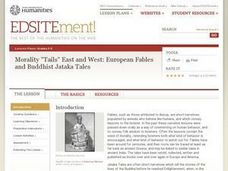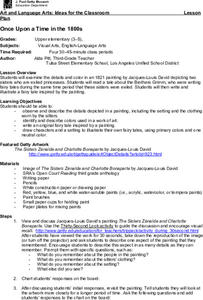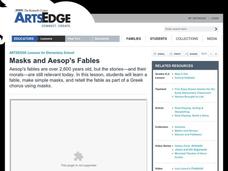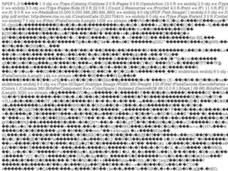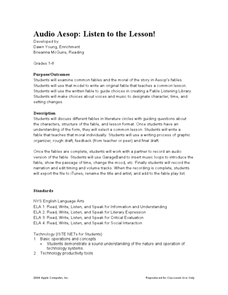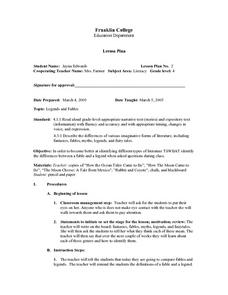Curated OER
Character Traits in Fables
Combining art, music, dance, and reading comprehension, this lesson plan is geared to reach all ability levels. After reading a variety of fables and discussing story elements and character traits, class members select a moral to use as...
Curated OER
Critical Thinking With Fables New and Old
Explore the fables of today along with Aesop's ancient fables. Learners will understand the structure of a fable, critically think about the fable's message, and create a lesson that they would like to teach through a fable. Suggested...
Curated OER
Those Fabulous Fables
A video leads off this activity on fables, introducing the class to this important form of traditional storytelling. The group defines fable and hears an explanation of the origin of this type of folk tale. They summarize the story they...
Curated OER
Fable Writing - Interdisciplinary Approach to Social Sciences
Before writing their own fables, class members select an animal or insect to use in their story and research its character, habits, movements, etc. After reading a wide variety of fables and identifying the elements of a fable, writers...
Curated OER
Aesop's Fables
Examine the fables of Aesop with your class. Pupils identify the morals of fables and role-play a scene from their favorite fable of Aesop. Additionally, they compose letters to a favorite character in the fable. Learners role-play again...
Curated OER
Writing and Presenting a Fable Using Research
Elementary and middle schoolers research animal facts and use them in a fable. First, they pair-share to find animal traits to use in writing a fable. They then complete a prewriting worksheet. After going through the writing process,...
Curated OER
The Coin and the Fable: Alaska quarter reverse
An Alaskan quarter and a book of fables is what you'll need to start this lesson. Learners will use the image of the bear and the salmon found on the reverse side of the Alaskan quarter as inspiration. They will compose a fable about the...
Curated OER
Tell It to the Judge - Persuasive Essay
Students write a persuasive essay that compares and contrasts a classic fairy tales with a fractured one. They use the writing process to complete and publish the essay.
Curated OER
Fabulous, Fractured Fables
Elementary schoolers develop an awareness of the literary form known as the fable. They explore how authors write fables to pass along moral lessons. After reading and discussing many famous fables embedded in the plan, learners attempt...
Curated OER
Morality "Tails" East and West: European Fables and Buddhist Jataka Tales
Have your class explore Buddhist Jataka Tales to compare and contrast them to European fables. After defining fables, Jataka tales, and the elements of each, learners identify themes and patterns for both types of narratives and the...
Curated OER
Once upon a Time in the 1800's
Young readers examine the details in an 1821 painting by Jacques-Louis David depicting two sisters who are exiled princesses. They read a tale about the Brothers Grimm, who were writing fairy tales during the same time period that these...
Curated OER
Masks and Aesop's Fables
Students study and perform Aesop's fables. In this Aesop's fables lesson, students read and/or listen to a number of the famous fables. They make masks based on the characters and perform a fable using the masks. They write about the...
Curated OER
Determining Author's Point of View: The Sneeches
Determine the author's point of view in a text. Young readers read Dr. Seuss' The Sneeches and identify the author's purpose in the story. They identify persuasive techniques in writing, asking and answering questions to better...
Curated OER
Writing A Fable - Pets
Students recognize the elements of a fable. In this writing a fable lesson, students discuss fables and write their own using the elements discussed.
Curated OER
Audio Aesop: Listen to the Lesson!
Aesop's Fables are the focus of this language arts instructional activity. Young philosophers study and discuss the morals found in the most famous of Aesop's Fables. They write an original fable that teaches a common moral. A "Fable...
Curated OER
How to Make Plurals of Words That End In "f" or "fe": A "F"able
Identify nouns that end in "f" or "fe." Review how to make words plural and the specific rules for words that end in "f" or "fe." Complete the fable activity sheet and find and write the plurals for words they find that end in "f" or...
Pearson
Catching the Sun: Tales from Asia
Explore the folklore of Asia and the South Pacific with this language arts instructional activity series. Complementing a reading of Catching the Sun: Tales from Asia by Jan M. Mike, this resource supports learners with understanding...
Curated OER
I Hate to Complain but your Cheese Stinks
Students read and discuss the "fractured" fairy tale "The Stinky Cheese Man". They imagine that they are in the fairy tale and write a letter of complaint concerning the Cheese Man and how he stinks up the town.
Curated OER
Fables and Trickster Tales Around the World
Students analyze fables and trickster tales from various cultural traditions. In this fable analysis lesson plan, students identify the elements of fables and trickster stories. Students read Aesop's fables and Ananse spider stories....
Curated OER
Fable Writing--Inter-disciplinary Approach To Social Sciences
Students recognize the elements of a fable and write an original fable. They make connections with morals and other law-related concepts.
Curated OER
Fantasy, Fables, Myths, Legends & Fairy Tales
Students identify the differences between fantasies, fables, myths, legends and fairy tales. In groups, they create their own versions of the different genres. They practice identifying the examples, as well.
Curated OER
Legends and Fables
Fourth graders identify and discuss the differences between legends and fables. They define fable and legend, then as a class take turns reading our books. Students select two of the stories, and complete a Venn diagram, comparing one...
Curated OER
Tell It to the Judge - Persuasive Essay
Students compare and contrast a classic fairy tale with a fractured one and complete a graphic organizer. Then they write a persuasive essay following the steps of the writing process. Finally, students publish their completed essay and...
Curated OER
I'm a Changed Pig
Introduce your class to fairy tales with this lesson. After reading the fractured fairy tale, "The Three Little Wolves and the Big Bad Pig," third, fourth, and fifth graders write a personal narrative as a response to the fairy tale....
Other popular searches
- Writing Fables and Folktales
- Writing Fables Middle School
- Writing Fables 4th Grade
- Writing Fables Grade 6
- Writing Fables Mind Map
- Writing Fables Gr 5
- Writing Fables Rubric
- Writing Fables Gr 2
- Writing Fables Animal Farm
- Writing Fables Gr 3
- Aesop's Fables and Writing
- Fables Six Traits Writing











